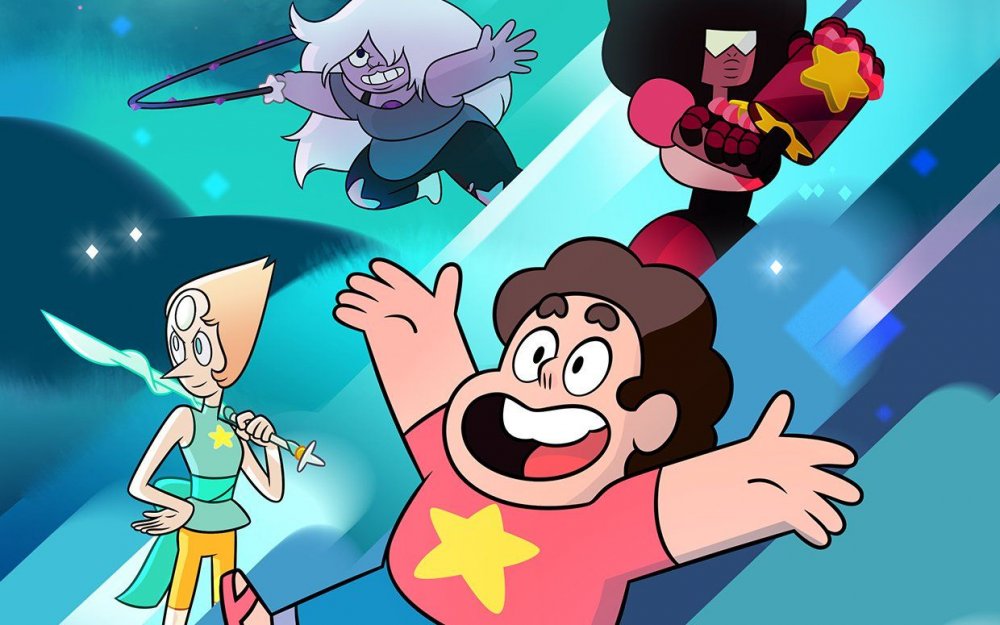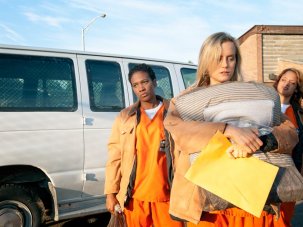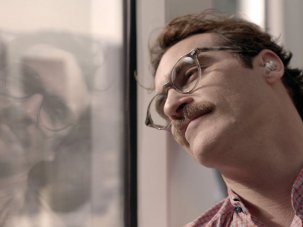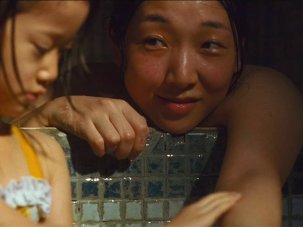Spoiler alert: this essay discusses plot twists in both Steven Universe and The Good Place
It opens with a pair of eyes. Something is awakening.
Steven Universe is available to download or stream on iTunes and Amazon Prime (series 1-11), Now TV (series 1-4) and Netflix (series 1).
The Good Place is available to stream on Netflix and to buy on iTunes and YouTube.
In the second episode of Steven Universe, they are typical American cartoon eyes, oval and white with a dark pupil. They are staring into the existential despair of an empty ice-cream freezer. The eyes belong to Steven, a young boy in a red T-shirt with a gold star in its centre, and their stereotypical cartoon nature is underlined by the similar eyes of the character represented on top of the ice cream fridge, Cookie Cat. In the course of the episode, Steven moves between despair and joy – on the surface, at finding more of the discontinued Cookie Cat ice cream sandwiches; underneath, at finding the secret to unleashing the magical superpower that makes him feel he belongs in his unusual family.
As he does, his pupils change shape. Taking advantage of the full range of animation (and drawing on tropes from anime), they fill his whole eye, spin in spirals of wonder, waver liquidly in tears, or shine out as stars, expressing his unabashed and changeable emotions.

Steven Universe (2013-)
Neither emotional openness nor the plasticity of animation are explicitly Steven’s superpowers, but they are the show’s: both the transformative and expressive powers of animation are used not just for their narrative potential, but for their political and ethical potential, too. Premiering in November 2013 on Cartoon Network in the US and running for 160 ten-minute episodes over five seasons, Steven Universe has been called not only “the best kids’ cartoon for adults, period” (Alexis Nedd for Mashable UK) and “this decade’s Avatar” (Matthew Dougherty for IGN) but “an animated revolution” (Alex Robert Ross for Huck Magazine) and “a defining example of artistic resistance in our time” (Kwame Opam for the Verge). Created by Rebecca Sugar, who became the first-ever female showrunner on Cartoon Network, the show is often described as progressive and socially conscious, and particularly praised for its radical empathy: for its commitment, like Steven’s, to the trifecta of chosen family, emotional openness and ethical practice.
All of the same descriptors could, and do, get applied to a show that seems very different: it’s live action rather than animation, rated 15 on Netflix UK rather than created for younger viewers, and based explicitly around the Western canon of moral philosophy, but The Good Place (NBC, 2017–) shares a candy-coloured landscape and fascination with plasticity – both of mise-en-scène and character – with Steven Universe.
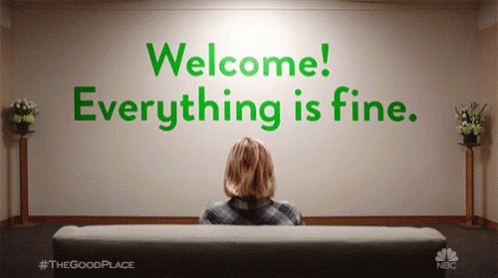
The Good Place (2017-)
Boasting 20-minute episodes (three series of 13 each thus far, with a final season just announced), it enjoys a similar punchiness to its cartoon kin, one that means baroque plot twists and an equally baroque sense of cosmic scale are packed into brief bites, moving with such speed that explaining the show would require the temporal equivalent of Jorge Luis Borges’ 1:1 scale map in On Exactitude in Science. The Good Place has a lot to say, and it says it fast and urgently. First broadcast in 2017, it feels like a ripped-from-the-headlines reaction to Donald Trump’s first year in office. With a far more caustic tone than Steven Universe, it still yearns and rages for that show’s potent belief in hope and change through collaboration and connection across difference.
Created in a more urgently ‘woke’ moment, The Good Place also shares, and one-ups, Steven Universe’s eye-opening opening. These eyes are seen in close-up, first closed and then springing open. They belong to a white American woman called Eleanor Shellstrop (Kristen Bell), who is immediately welcomed to the Good Place by the kindly Michael (Ted Danson).
The Good Place trailer
Wandering through punningly titled frozen yoghurt parlours (both shows love a frozen dessert), Eleanor is told that she is now in the afterlife, in a neighbourhood designed for its inhabitants by Michael, its architect, and built by Janet (D’Arcy Carden), an omniscient interface who also acts like an embodied Siri or Alexa for the residents. As Robin James points out in LA Review of Books, the show’s gender politics – as embodied differently by self-proclaimed “trashbag” Eleanor and “not a girl, not a robot” Janet – are one of its most subtle and most compelling elements. The show was created by Michael Schur, who also gave us feminist icons Leslie Knope (Amy Poehler) in Parks and Recreation, and Rosa Diaz (Stephanie Beatriz) in Brooklyn Nine Nine.
Eleanor gladly accepts Janet’s assistance and revels briefly in the magical, seemingly infinite possibilities of her new afterlife – until she realises two things: that she has been assigned to live in a house full of hideous clown paintings with her complete opposite, whom she is told is her eternal soulmate, an uptight Senegalese moral philosophy professor called Chidi Anagonye (William Jackson Harper); and that these are clear signs the Good Place has got the wrong Eleanor Shellstrop. Chidi and the clown paintings should accompany a selfless human rights lawyer of the same name who died helping others, while this Eleanor died trying to retrieve a bottle of tequila mixer in a supermarket carpark.
Someone Royally Forked Up in Season 1 of The Good Place
Thinking that her mis-assignment has caused a storm of giant flying shrimp and a trash tornado, Eleanor follows the All-American logic of Al-Anon and, having hit bottom (that is, realising she’s destined for the Bad Place), finally asks for help. Even though she can’t pronounce his name, she enrols Chidi as a philosophy teacher, and his class soon expands to include their neighbours, competitive name-dropping British philanthropist Tahani al-Jamil (Jameela Jamil) and Jianyu – aka Jason Mendoza (Manny Jacinto), another case of Good Place mistaken identity who is not a silent Buddhist monk but a failed DJ, failed drug dealer, failed safe breaker and minor-league breakdancer.
It gradually dawns on both the characters and the audience that such a hellacious combination (plus the endless frozen yoghurt) might have more in common with Jean-Paul Sartre’s set-up in Huis Clos than any idea of a benevolent afterlife. While the fear of being discovered and sent to the Bad Place keeps Eleanor and Jason in line for a while, gradually Chidi’s lessons and the foursome’s growing friendship leads them to a Season 1-closing realisation (spoiler alert): this is the Bad Place. Michael may be an afterlife architect, but he is working for the Bad Place and this is his first experiment in a new form of Sartrean torture.
The mindgames meant to destroy the four subjects, however, nearly destroy the neighbourhood instead, as the foursome’s collaboration and care for each other cracks Michael’s puzzles – repeatedly, as Season 2 shows Michael “re-booting” the characters and neighbourhood with minor variations over thousands of versions, always with a similar result: the characters band together, learn philosophy, and work out where they are. Then get rebooted. Like Steven (who accidentally clones himself, creating an alternate timeline, and then has to get rid of his clone), The Good Place characters could sing: “I learned to stay true to myself / By watching myself die.”
Chidi’s near-death thesis idea in Season 3 of The Good Place
This is a daring step beyond the comic realism, however verbally sur- at times, of Schur’s previous shows, and even the light science fiction of the final series of Parks and Recreation (Knope for President!). The Good Place explicitly announces itself as, first, a medieval morality play complete with its version of God (Judge Gen, played by Maya Rudolph as a snappy functionary with a short attention span) and the Devil (Shawn, played by Marc Evan Jackson as an evil version of his persnickety professor Kevin from Nine Nine – at one point Shawn is even tortured with the threat of a lifetime of unread New Yorkers, in a neat crossover joke); second, a post Inception fantasia of the CGI possibilities of collapsing and interconnecting realities; third, an illustrated moral philosophy problem; and fourth, because this is Schur, Americaniser of The Office, also a workplace comedy.
It literalises the idea that all work, especially under neoliberal capitalism, is hell. And indeed, that it’s hell because it’s all-pervasive: it takes one episode for Eleanor’s house to become a workplace (Chidi barely gets a sabbatical), and by the fourth episode of Season 2, the foursome have teamed up with Michael and Janet to change the neighbourhood, and Michael has joined the school.
Talking to Cate Young for Bitch magazine, Cord Jefferson, one of the show’s staff writers, noted that: “Research and recent history shows that human beings band together in times of need. That’s something The Good Place does; it shows that if you put these people in very stressful situations, they’re going to help each other. Everybody’s life is better if you’re willing to help your neighbour.”
All the Feel-Good Moments in The Good Place
Jefferson could be drawing his ideas from Rebecca Solnit’s study of what she calls “disaster communities”, A Paradise Built in Hell, a title that The Good Place literalises. Solnit studied grassroots community interactions and support networks during disasters such as Hurricane Katrina, finding that neighbourhood operations on the ground were more successful and sustaining than state intervention.
Solnit’s description of these communities resonates deeply with what Jefferson and the writers’ room depict on The Good Place: “The positive emotions that arise in these unpromising circumstances demonstrate that social ties and meaningful work are deeply desired, readily improvised, and intensely rewarding… We need ties, but they, along with purposefulness, immediacy, and agency, also give us joy – the startling, sharp joy found in the accounts of disaster survivors [which…] comes, when it comes… from an affection that is not private and personal but civic… of doing the work that matters.”
How Afterlife points are assigned in The Good Place
In The Good Place, work is hell, hell is work – and yet it is working together for each other, and for a larger cause (changing the whole accounting system that assigns people to the Good Place or Bad Place, ie. the underlying moral structure of the universe), rather than for the system, that connects the characters, empowers their resistance, and leads to change. Call it collective bargaining. In The Good Place, hell is harrowed by the damned themselves, in search of better working conditions.
~
Oddly, given it’s a cartoon aimed at children, Steven Universe is similarly a show about the millennial practice of working (constantly) from and at home, while organising to change and/or save the world – and working conditions.
Steven shares his clifftop home near the fading boardwalk of Beach City with three Crystal Gems named Garnet, Amethyst and Pearl: mineral-based aliens from a distant planet they call Homeworld. Steven’s mother was another Gem, Rose Quartz, who led a rebellion against Homeworld’s colonisation of earth and the employment of Gems as soldiers, miners and overseers, then stayed behind with her friends to clean up the damage.
Steven and the Crystal Gems, a song from Steven Universe
Millennia later, Rose heard the songs of a young human musician called Greg Universe and fell in love – who wouldn’t love a song called Let Me Drive My Van (Into Your Heart)? – eventually creating Steven with him, which results in her demise. So her three comrades take over collective responsibility for Steven – and for planet Earth, defending against further colonisation and ecological disaster.
Raised by three shape-shifting, centipeetle-fighting superheroes, Steven is desperate for his own gem – his mother’s rose quartz, now embedded in his bellybutton – to activate so he can shift from being a responsibility to taking responsibility. As Steven comes into his powers, he realises his home is also a workplace: each Gem has her own personalised gemspace for training; there is a storage space where they keep the Gems they capture that were damaged by the colonisation and war; and there’s a transporter pad that links them to other similar pads around the universe, so they can go where they are needed.
And they are always needed, due to the devastation caused by Homeworld. Work never stops. By Season 2, Steven’s human friend Connie is training with the Gems too, and Greg is fixing extraterrestrial sonic devices: all hands are on deck against increasing threats from Homeworld, who want their colony back.
As in The Good Place, there is a strong sense that such voluntary – and collective – activist work differs meaningfully from paid labour under capitalism, such as Steven’s friends Lars and Sadie’s repetitive jobs at the town’s doughnut shop. Via Steven’s defining curiosity and generosity, everyone comes to realise they can contribute to the struggle and thus liberate themselves: Sadie eventually quits her job to become a goth rock singer (the show’s wide-ranging, witty musical pastiches are another of its superpowers), while the relentlessly nihilistic Lars finds himself via a more intergalactic calling (and a cape), helping some Homeworld outcasts.
Steven makes Lars cool in Steven Universe
The show ends with a literally motley crew, including former Gem enemies once focused on destruction, gathered in Beach City through Steven’s refusal to be anyone other than himself. His full identity, in relation to Rose Quartz, is the show’s biggest, sweetest and most moving twist (if you don’t mind spoilers, Julie Muncy writes beautifully about it).
Like several other climatic moments in the show, the finale depends on a particular Gem superpower called fusion, which allows Gems to merge with each other (via dance) to create larger, more powerful mineral life-forms, a power that horrifies the purist Diamonds of Homeworld. The allegorical power of fusion has been key to praise for the show’s LGBTQI+ inclusivity, which included the first same-sex marriage proposal in American animation, between two Gems who are also a fusion.
The series won a GLAAD Media Award for Outstanding Kids & Family Program in 2019, becoming the first animated series to win the award, and was also an honor nominee for the James Tiptree Jr. Award, which rewards work in science fiction and fantasy that expands the boundaries of gender and sexuality. The show’s commitment to social justice and collective action is rooted in its celebration of gender and sexual diversity: Steven’s reaction to the first fusion he sees is to sing: “All I wanna do / Is see you turn into / A giant woman”, and he later fuses with Connie to become a non-binary character called Stevonnie.
Giant Woman, a song from Steven Universe
In foregrounding chosen family, a particularly queer concept, the show also takes a diversity of relationships seriously, centring the radical possibility of committed friendships such as Steven’s and Connie’s, as well as the odd couple of Peridot, a former Homeworld soldier who calls all Gems and humans “clods”, and former Homeworld prisoner Lapis. While the show’s universe-saving arc narrative is well-structured and coherent, most of the dramatic twists emerge from character relationships and the ethical discussions these prompt – including, in the case of fusions, with themselves.
Season 1 ends with the reunion of a fused Gem, celebrated in the song Stronger than You, in which the Gem refers to herself as “a conversation”. Where The Good Place has its philosophy lessons – which are sometimes dynamically dramatised, as when Michael makes the famous ‘trolley problem’ gruesomely real – Steven Universe has its songs, which often concern the consequences of a character’s actions towards another. While all animation is technically sequential, very few traditional animated shows are con-sequential: not only building character arcs, but locating those arcs in ethical decisions that follow all the way through the show.
~
In a sense, The Good Place is an extended joke on an older mode of television often called ‘reboot TV’ (before all of TV became actual reboots of old shows), referring to series where characters would forget consequential decisions and information between episodes so that they remained unchanging; particularly in sitcoms, this created a useful (and relaxing) set of expectations and repetitions for viewers.
Like Steven Universe, however, The Good Place shows that both narrative and humour arise from how the characters change (and change each other), with “trashbag” Eleanor not only learning from Chidi but also shaking him out of his moral paralysis to the point he’ll have sex with her in a closet in the mail room of the actual Good Place. And not only the humans: ancient demon Michael has an existential crisis (in an episode subtly titled Existential Crisis), mainly expressed by wearing a white suit and Drakkar Noir (a phrase Danson delivers with hyper-panache).
Michael’s Midlife Crisis in Season 2 of The Good Place
It is Janet, however, who changes the most, starting from the most static position, both in that she is an omniscient, omnipotent interface, and that she is treated like a personal assistant. Every time Michael reboots the neighbourhood (thus wiping the humans’ memories), he also has to reboot Janet. Unlike the humans, Janet is programmed to remember each of her iterations.
In computing terms, Janet is thus an emergent network, and offers a rare positive example of an evolving AI. She is the opposite of HAL not only in that reboots leave her mistaking cacti for files until Michael has a very succulent office, but in that what she learns is to be more Schur-human: prickly, sure, but also generous, vulnerable, and emotionally open. Rather than answering to her programming, she – like Eleanor – learns to help others because she wants to, out of friendship.
Janet, who seems so infinitely superior, has begun to learn from humans; mainly, she learns to fall in love with Jason, the character who most remains his hopeless self. This is particularly, and productively, confusing and lovely in the mid-Season 3 episode Janet(s), when Janet hides the humans in her inner void, a totally blank space, where all of them then appear as Janet.
A mashup of Janet’s Finest Moments in The Good Place
Janet-Janet has to hide her true feelings and act as go-between for Tahani-Janet and Jason-Janet, who are in a relationship. Meanwhile, Eleanor-Janet and Chidi-Janet have the most important conversation of their relationship(s), one so devastatingly honest it causes Eleanor-Janet to flicker through the visual identity of every human the Janet programme has ever encountered to represent her fear she lacks a core self. Then the Eleanor and Chidi Janets kiss.
The Good Place, like Steven Universe, has an extensive LGBTQI+ fandom, not so much because of Eleanor’s repeated reference to her unactuated crush on Tahani as because of its investment in plasticity and plurality. Its Janetness, essentially: Janet embodies possibility, both hope and change. She is the show’s breakout character, and Carden its breakout performer. Whether learning how to imitate a Bad Place Janet (ie. Carden performing herself performing another of her roles), vomiting pennies, playing all of the show’s human characters, or repeatedly begging not to be rebooted – a failsafe that she describes as meaningless but that becomes increasingly agonising to watch – Carden’s characterisation of Janet expresses both hope and change. She starts out embodying all-powerful perfection, yet – in a show whose commitment to moral philosophy seems to endorse Rousseau’s Enlightenment notion of the perfectibility of man – she glitches a little more with each reboot.
When Janet turns to an utterly bereft Eleanor in the final episode of Season 3, and says “I gotchu, dawg,” it might seem like an underwhelming phrase with which to face the combined forces of hell. But the simplicity of Janet quoting the irredeemably Jacksonville Jason proffers the perfect expression of the show.
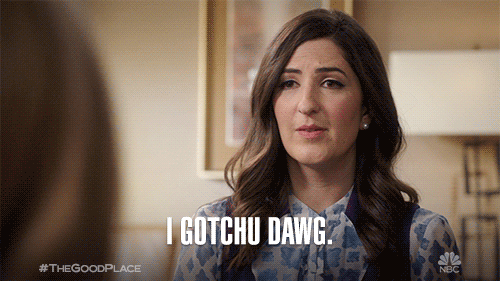
The Good Place (2017-)
Steven Universe makes its compelling emotional mileage from a similarly self-aware use of pop-cultural understatement. “We’re good and evil never beats us,” sings Steven in the extended version of the theme song. “We’ll win the fight and we’ll go out for pizzas.”
Yet the show is far from the snark of The Simpsons, or of Adventure Time, on which Sugar also worked. While it hymns “peace and love on the planet Earth”, it also clearly refers to issues such as environmental exploitation, indigenous genocide, slavery, industrialisation, disinformation and nativism. Earth’s peace and love is precarious and provisional, predicated on all of us taking responsibility for it. As Connie sings, bittersweetly, “With my short existence / I can make a difference.”
Do It for Her, a song from Steven Universe
Despite its predominantly pink tones and starry-eyed musical numbers, Steven Universe is – like The Good Place – far from simply utopian. But both shows remain committed, in their disaster communities, to the hopey-changey stuff. In other words (to paraphrase Ursula K. Le Guin), you cannot buy the good place, you cannot make the good place, you can only be the good place: it is the Steven Universe in your spirit, or it is nowhere.
-
The Digital Edition and Archive quick link
Log in here to your digital edition and archive subscription, take a look at the packages on offer and buy a subscription.




